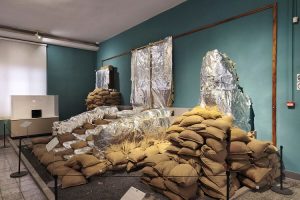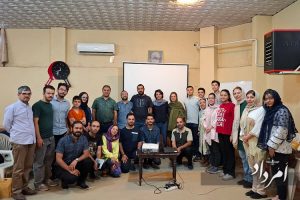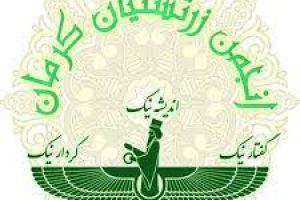As we approach Nowrooz, with all the changes in life compared to the past, as well as physical and mental ups and downs, or worldly and hereafter. More than anything I miss our home in Abadan and those New Years. Wherever I am, whether in Abadan, Yazd, or Tehran (the three cities where I spent most of my life and youth) or when I am far from Iran, I like to stand in front of a window in the morning and watch the outside.
In Abadan, where we lived (1950s and 60s), the view outside the windows was a small garden with a willow tree next to a water pond and a konâr tree in the other corner, and whatever that our father had planted, which were already sprouting. In the tropical climate of Abadan nature became colorful earlier than in colder places. During Nowrooz days, the nightingales laid their eggs, and we would wait eagerly to see them hatch. My father had some date nightingales (gray, with white ears and yellow tails) in a cage and they chirped so pleasantly in the mornings.
As a child, my siblings and I enjoyed both indoor and outdoor activities, finding something new every day. Our family benefited from the economic stability they provided by the National Oil Company during the city’s economic boom, ensuring our basic needs were met. Despite societal shortcomings, there was a sense of happiness and hope. We spent much of our time playing with neighbors and tending to our garden, which housed various animals including a friendly German dog named Jackie. We eagerly anticipated holidays, when we could freely explore the market and indulge in treats like Vitana or Mino biscuit boxes filled with games.
Fifty years later (at the end of December 2011), when I went to Abadan with two of my elementary school friends, I visited our old alley in bahmanshir, once again. Bahmanshir is an ancient name that is made from two words, “Bahman” and “Ardeshir,” and is related to the Sassanid period (see Iranika 1). This is the name of a river that branches off from the left bank of Karun River and flows for 70 km, parallel to the Arvand River (its ancient name Arunte) towards the Pars Sea (Persian Gulf). The name of this river was given to the village of the same name after the establishment of the Iran-British Oil Company, which after 1953, turned into “National Iranian Oil Company”, and where the oil company built a housing neighborhood. Our house was located on the corner of R 36 Alley. Our street, neighborhood, and house looked discolored, poor, and depressing. Apart from the size of the garden around our old house, which had become much smaller in my eyes, it also looked much more cluttered than when we were there in the forties and fifties. A palm tree was planted in place of the Konar tree, which had grown very tall. The whole garden was covered with weeds and wild bushes (photo 1).

Unlike those days when our father used to look after the garden and keep it organized. I remember that my father (may his soul rest in peace) used to plant corn in two or three rows in orderly and parallel plots in the Yazdi style. In addition, at that time, the Oil Company would make sure that the alley and streets in the neighborhood of the Oil company were kept clean, green and orderly (photo 3). But now, there was no sign of such a landscape left. The main brook that flowed through our alley (and a part of it was in the open) was now full of dirt and reeds. Our old neighborhood, a part of Bahmanshir River delta, was returning its old self: a delta full of reeds. In place of the konar trees, there were date palms everywhere!

Years later, starting from 1980, I lived in Tehran’s Fisherabad neighborhood on Malik Al-Kalami Alley, renting a house from a kind landlady named Marvarid Khanum Shahgoshtasbi. Despite the war’s frightening realities during the Iraq-Iran conflict, with rockets and air attacks being a constant threat, we managed to hold onto our traditions, finding solace in planting greens and preparing for Nowrooz, despite the challenges of raising a three-week-old child in such circumstances.
In our rented house in Tehran, we cherished two tiny gardens, each two-by-two meters in size, adorned with cedar trees and various flowers and vegetables according to the season. Every late March morning, we eagerly awaited the blossoming of the flowers from our windows overlooking the yard. One year, after Nowrooz, and just two days before nature’s day (13th Farvardin) my wife woke me up early morning to watch the snow that had covered the yard. Looking from the window I was astonished to see the entire yard blanketed in snow. In this house we did not have a window facing the north (towards the Alborz range), but I remember that in the early 70s, when visiting a friend, in that same vicinity, I watched the magnificent Alborz mountains covered in snow, from their window.
In 2010, the windows of that house were covered with thick curtains, because a towering skyscraper built by the Oil Co, was now obstructing the scenery of the alborz mountains. I remember that in those days, when my two sons were small, we would visit our family and relatives, who resided in Tehran, during Nowrooz holidays.

In the early 1981, we relocated to Yazd, where we eventually built a home filled with love and hope. Despite initial fears about bank loans and construction materials, we persevered, gradually constructing our house. Over time, we transformed the surrounding soil, cultivating a garden that flourished with a central pond, two vines, a fig tree, and a magnificent orange tree. These plants held sentimental value, with the grape and orange tree reminiscent of my wife’s father, a respected figure from Qasemabad, Yazd, and the fig tree a gift from my brother’s father-in-law in Narsi Abad.
The first year we moved into our newly built house, it was the end of March, and the scent of fresh paint lingered in the air. Our garden boasted only newly planted seedlings at the time. Years later, as I gazed out the windows, a flourishing garden greeted me! Rose bushes and two majestic Majnoon mulberry bushes surrounded the small water pond, alongside vine and jasmine trellises. Every morning, I eagerly awaited the sight of fresh leaves or blossoms. Nowrooz brought us immense joy as it marked a time for our family to be together. With a few days of free time for both my wife and me after months of continuous work, and the children off from school for two weeks, we cherished our moments of togetherness.
The last Nowrooz we shared with our family and beloved parents-in-law was in 1993, a cherished memory we didn’t fully appreciate at the time. Our home was filled with delightful scents of jasmine and orange blossoms, accompanied by the sweet songs of nightingales from our trees. It’s remarkable how these birds adapted to our cold Yazd winters. Our garden and the city’s bustling birdlife brought us immense joy, amidst economic uncertainties and growing environmental concerns. Let’s return to the joy of Nowrooz, celebrating with Hajifirouz’s dance and watching small fish swim in tabletop fountains, as we revel in the delightful days sung by Farhad Mehrad.

I wanted to plant a tree today in memory of Nowrooz 1993, and the days when we were together with our family, but the cold and the fog didn’t allow. I must do it next week. It is 30 years since I made this promise!
*Dr. Dariush Mehrshahi: member, retired from the Department of Geography, Yazd University.










